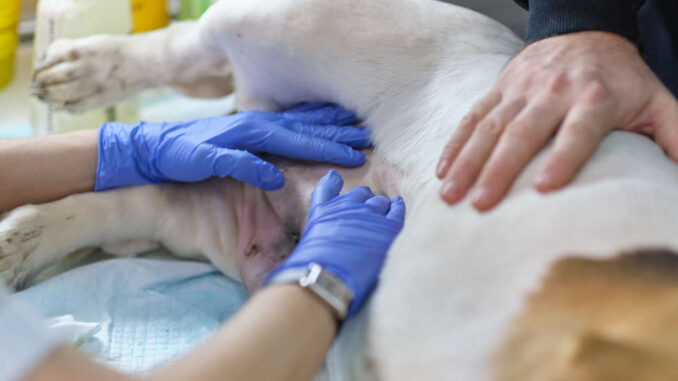
This article was updated on December 7th, 2023

If you’ve ever owned a dog, you might have noticed that they often suffer from various skin problems such as skin rashes. A common rash that can occur in your pup is a groin rash on the lower abdomen. Generally not serious, having a dog with a groin rash isn’t fun and it could be caused by any number of things.
But don’t fret. I see this issue commonly in my clinic and I have compiled a list of the top reasons, along with what to do to solve the issue.
Key highlights:
– A mild groin rash can sometimes go away on its own in a few days
– A groin rash can also be caused by medical conditions that require veterinary treatment (for example, allergies or skin infections)
– Contact your vet to diagnose the cause and determine the appropriate treatment
– Most cases can be treated with creams and medications reflective of the rash’s cause
– Some vet-recommended home remedies like skin balms, hydrocortisone cream, and medicated shampoo may help
5 things you should know about a groin rash on a dog
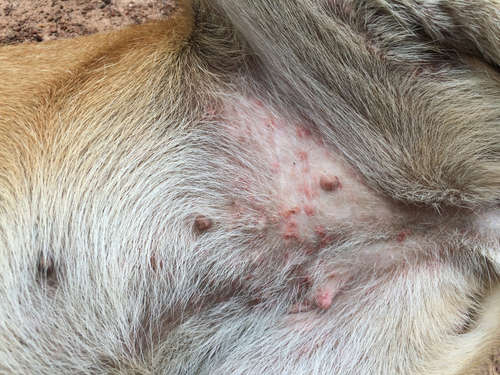
Noticing a groin rash on dog skin can be frustrating for any pet owner, especially when you’re worried about the possible cause and its impact on your dog. Let’s get into learning more about this canine conundrum and find out how best to tackle it!
1. Some groin rashes go away on their own in a few days
In most cases, minor rashes can be treated at home:
“When the dog is unbothered by the rash and the signs are mild, we may choose to take a wait and see approach. The good news is that some skin rashes in dogs do go away on their own. A rash that is mild and causing no discomfort may well go away within a few days. “
If you find signs are improving each day and the rash is shrinking, it is sensible to monitor the situation closely from home.
Mild contact dermatitis reactions (such as after lying on an irritant plant or a reaction to a fabric cleaner) should resolve within 2-3 days as long as there are no complications. Similarly, a rash that has arisen from an insect sting will usually be gone within a week.
“It’s important to pay attention to the condition of the rash and monitor it closely. If it spreads or becomes worse, it will likely need veterinary attention.”
If you see other signs such as the ones outlined in the next section, you should take your dog to the vet before the condition gets worse.
2. Signs of irritation warrant a vet visit (when the dog scratches or licks at their groin)
Signs of irritation (including scratching, licking or chewing at the groin) warrant a vet check. Similarly, if the lesion is oozing or if there is a foul smell, this could indicate an infection and it is best to book the dog in for an exam.
Signs that the rash should be checked by a vet include:
- A rash that is spreading or worsening, rather than improving with time
- Ooze or discharge
- A foul smell
- Discomfort or irritation associated with the rash, which may cause the dog to scratch, lick or chew
- Signs of infection like pus or abscess formation
- Any additional symptoms such as a fever, lethargy or raised lymph nodes
If left untreated, a rash can cause scarring and infection in the deeper tissues of the skin. Dogs can also cause themselves a lot of harm from the excessive scratching that they do to themselves.
“If your dog is causing extreme damage to themself through scratching or licking or showing any other symptoms such as vomiting, lethargy, or breathing difficulties, then they need veterinary intervention ASAP.”
3. Allergies, infections, parasites, and poor hygiene are the most common groin rash causes
There are numerous reasons a groin rash can appear on your pet, ranging from allergies to poor hygiene. It is important to determine the underlying cause of the rash in order to treat it properly and prevent it from worsening.
One step you can take is to identify the cause of the rash. Is it due to an allergic reaction, a skin infection, or a parasite infestation? Think about potential allergens – have you walked your dog anywhere new, or is the pollen count high at the moment? Or perhaps you’ve started using a new cleaning agent at home? All of these can cause an allergic reaction.
Here are some of the most common causes:
1. Allergies
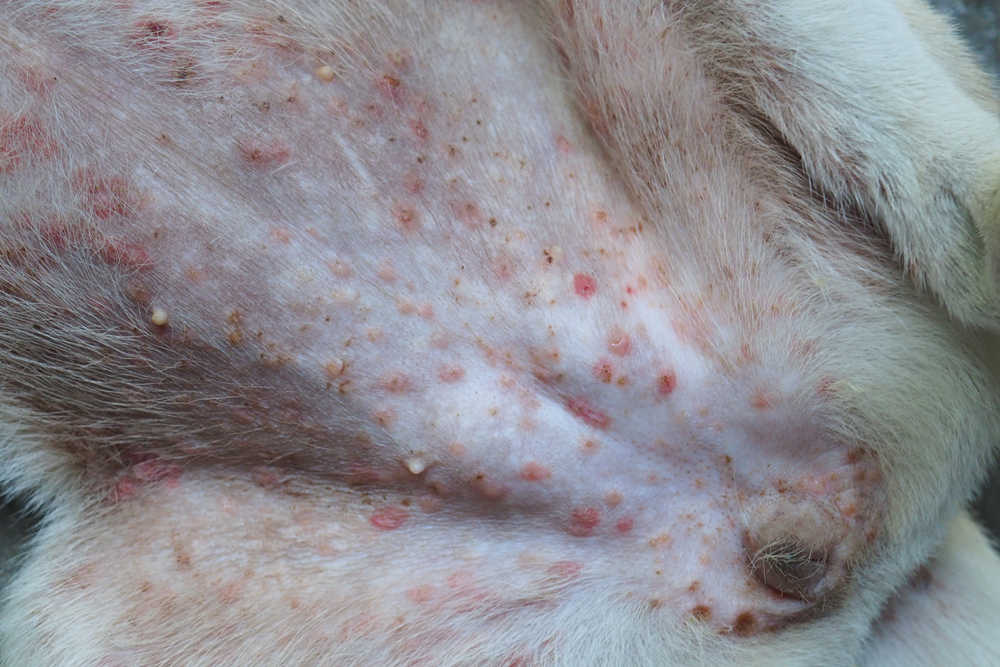
Your pup may be allergic to something that is coming into contact with the skin, such as a certain detergent or fabric. Dogs can also develop an allergic response when exposed to certain plants, foods, and environmental irritants.
How do you know if your dog has allergy issues? Symptoms can include any of the following:
- Itching and scratching – this is the number one sign observed in dogs with allergies
- Red, irritated skin
- Patchy hair loss (often due to scratching) or thinning coat
- Ear infections or inflammation
- Sneezing and coughing (allergic reactions to environmental allergens)
- Hives: small, raised bumps on the surface of your dog’s skin.
The symptoms can range from mild to severe but are generally easily treatable by your vet through the use of anti-inflammatory creams, steroids, and antihistamines.
Learn more about skin rashes due to allergies.
2. Bacterial Skin Infections
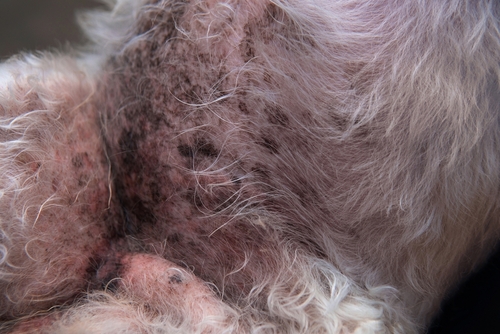
A bacterial infection may be present in the groin area if your pup has not been bathed recently or if there is an accumulation of sweat and/or dirt in the area. Common signs that your dog has a bacterial skin infection include:
- Redness, pustules, or papules
- Crusty scabs or lesions with flaky skin
- Swelling, oozing or draining of a blood-tinged fluid or pus
- Small red bumps
- Hair loss
Bacterial infections can also occur secondary to other issues, such as allergies or wounds.
Learn more about bacterial skin infections.
“For bacterial skin infections, veterinary treatment usually involves antibiotic creams and medicated shampoos; in severe cases, oral antibiotics may also be required.”
3. Fungal Infections
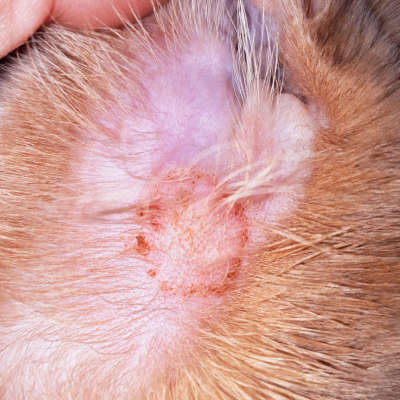
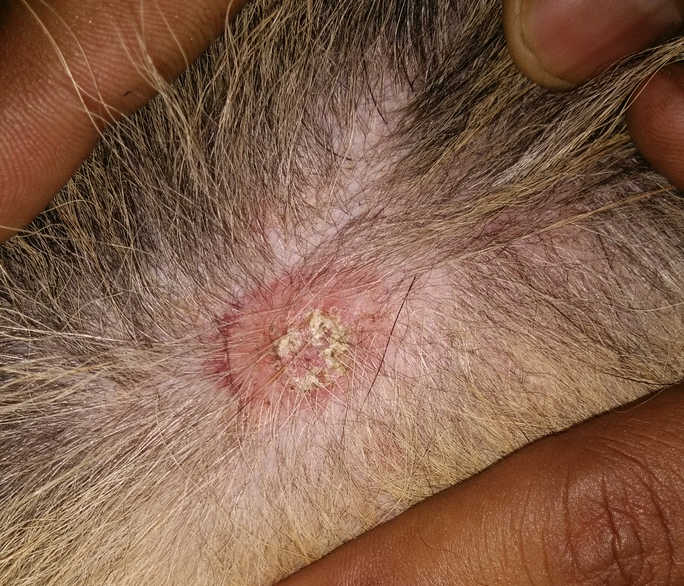
The most common type of fungal infection affecting the skin is ringworm. Common symptoms include:
– ring-shaped red scaly patches on the skin,
– bald spots, and
– intense itching.
Ringworm is highly contagious and can be spread from other animals and pets to humans. Treatment typically involves anti-fungal creams and tablets, as well as frequent cleaning of the affected area.
View pictures of ringworms and fungal infections.
4. Parasites
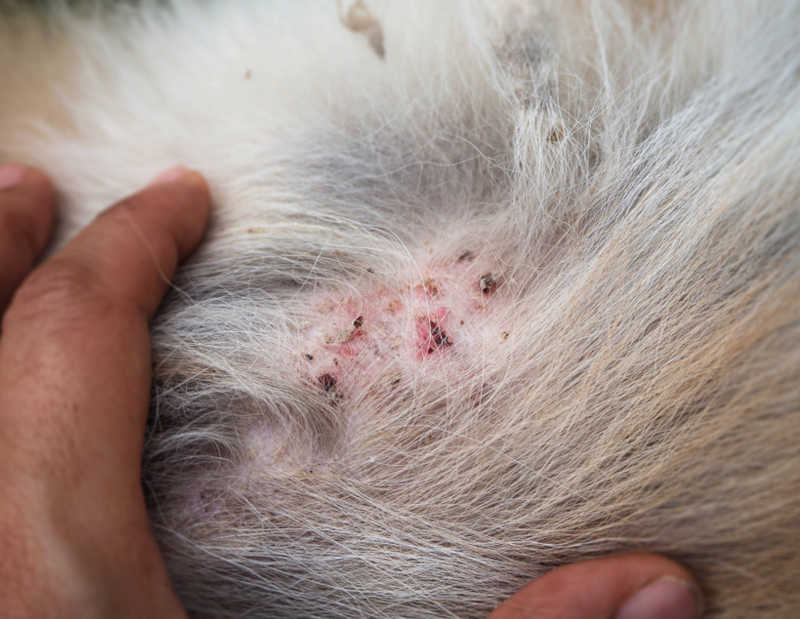
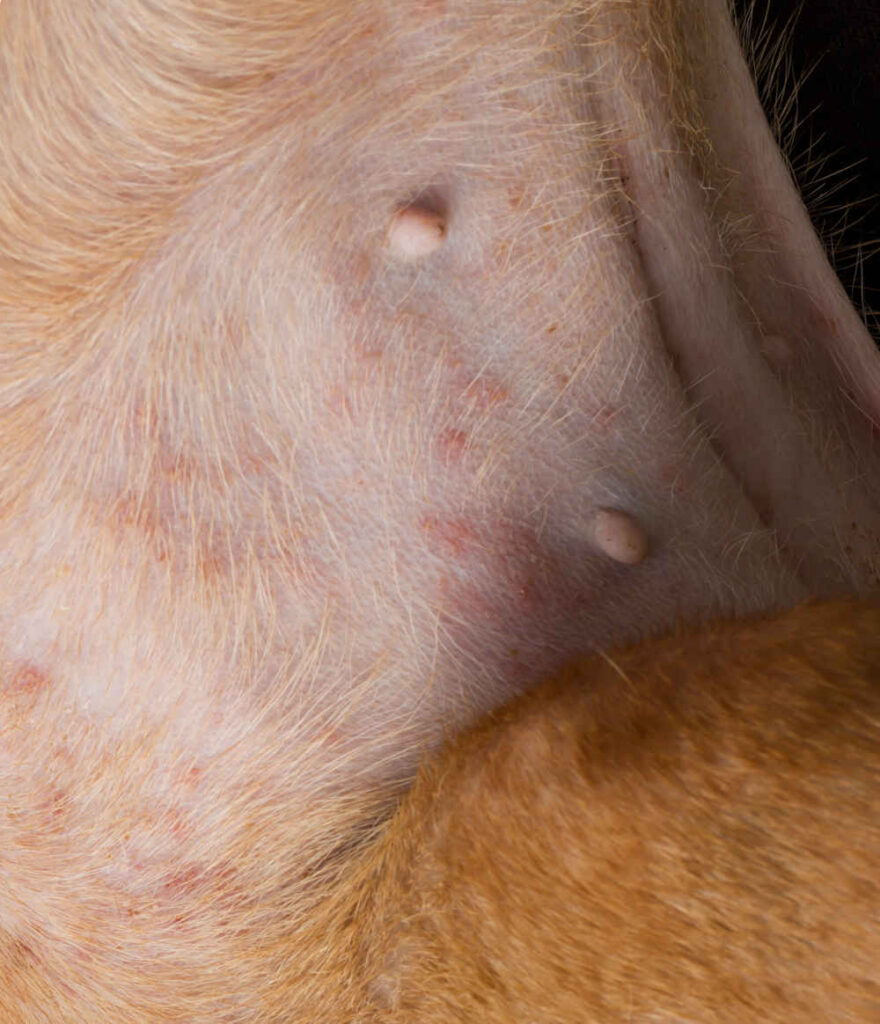
Certain parasites, such as fleas, mites, and ticks, can cause a rash in the groin area. These typically present as small raised red bumps on the skin that can be accompanied by itching and scratching.
In the case of ticks, you may see the body of the tick sticking out of the skin as a white lump. Treatment of parasitic infestations involves using flea, tick, and mite medications to kill the parasites.
View more pictures of tick scabs and flea scabs in dogs.
5. Poor Hygiene
Allowing sweat, dirt, and other debris to accumulate in the groin area can lead to a rash. This is especially common in breeds with thick coats, such as Labradors and German Shepherds. Providing regular baths and grooming will help to keep your pup’s skin healthy and free from any irritation or infection.
6. Hormonal Imbalance
An imbalance in hormones can cause inflammation of the skin, leading to a rash. This is more common in female dogs as their hormones fluctuate during the heat cycle. If your pup is exhibiting signs of a hormonal imbalance, it is best to visit your vet for a proper diagnosis and treatment plan.
4. Home remedies like skin balms, hydrocortisone cream, and medicated shampoo can sometimes help
In mild cases, the following suggestions might be helpful:
Keep your dog’s groin area clean and dry to prevent further irritation. Avoid using harsh soaps or products that can aggravate the skin. Instead, opt for gentle shampoos and ointments recommended by your vet. If these solutions don’t work, then there are a few home remedies that you can try.
One of the highly recommended options is an all-natural skin balm that contains soothing ingredients like aloe vera and chamomile to help reduce inflammation and itching. Below is a soothing ointment that might provide some relief from soreness:
- BEST IN PET SKIN CARE: Our cat allergy relief for cats is anti itch moisturizing lotion for DRY ITCHY SKIN fits all cat first aid needs! SOOTHES & HYDRATES as a healing ointment for pets –Cat Dermatitis Treatment for Cat Scabies or Cat Mange Treatment, Nose + Paw Butter for cats, a Burn Gel, Cat Acne Treatment, plus Hotspot, Rashes, Minor Cuts, Bites, Wounds + More. Made in a USA, GMP certified, lab tested facility for standards you can trust.
Hydrocortisone cream can also provide some relief as it contains a low-potency steroid that acts as an anti-inflammatory. Hydrocortisone cream is a steroid cream that can reduce inflammation and itchiness. Apply to the affected area twice daily:
- Provides gentle, soothing relief from skin irritations like itchy skin, hot spots, dermatitis & more
Another great product is a medicated shampoo that can gently cleanse and soothe the affected area. Whatever product you choose, it’s important to consult with your veterinarian to ensure that it’s safe and effective for your pet’s specific needs. Apply the shampoo in a lather and leave to work for 10 minutes before rinsing off. Here is a product I would recommend trying:
- Relief of Scaling and Itching from Dermatitis, Skin Infections, and Follicular Plugging to Stop Scratching and Pain.
5. Samples, swabs, and tests can help diagnose the cause of a groin rash on dog skin
Your vet will be able to diagnose the underlying cause of your dog’s groin rash. Skin samples and swabs are often taken to examine under the microscope for any underlying causes. Blood tests may also be recommended. Your vet can then provide medications, such as antibacterial creams, antifungal ointments, or steroids.
Frequently Asked Questions
Can I use over-the-counter drugs to cure the groin rash on my dog’s skin?
Be careful when using over-the-counter medications for your dog’s rash, and always consult with your veterinarian before giving your dog any medications. Over-the-counter drugs may contain ingredients that could be toxic to your pet and they may not be suitable for the specific condition you are trying to address. You can try some of the products mentioned above, but if these don’t help, then take your dog to the vet.
Can groin rash lead to something serious if not treated on time?
Yes, if left untreated, groin rash can lead to other more serious conditions, such as skin infections or even sepsis in extreme circumstances. It’s important to take your for veterinary care if the rash persists after home treatment.
Related Post: Pictures of Belly Rashes on Dogs
Disclaimer: This website's content is not a substitute for veterinary care. Always consult with your veterinarian for healthcare decisions. Read More.







Be the first to comment